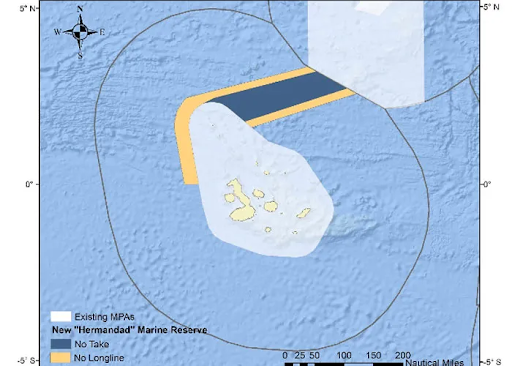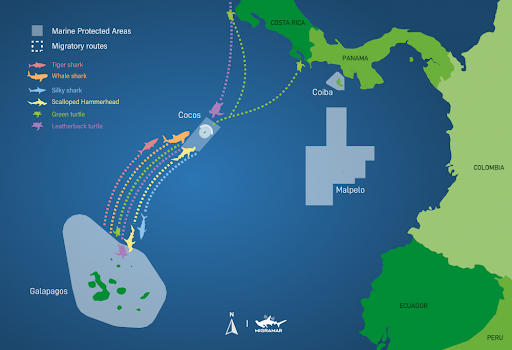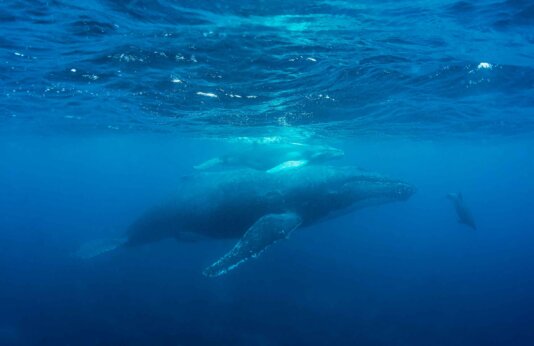- About
- Topics
- Picks
- Audio
- Story
- In-Depth
- Opinion
- News
- Donate
- Signup for our newsletterOur Editors' Best Picks.Send
Read, Debate: Engage.
| June 24, 2023 | |
|---|---|
| topic: | Conservation |
| tags: | #Ecuador, #marine conservatoin, #illegal fishing, #plastic pollution |
| located: | Ecuador, Costa Rica, Colombia |
| by: | Ellen Nemitz |
The ocean has taken centre stage in 2023. In March, the United Nations announced a monumental Ocean Treaty reached by the Intergovernmental Conference on Marine Biodiversity of Areas Beyond National Jurisdiction. Just two months later, on 9 May, Ecuador also made history by striking a deal to convert a billion dollar debt into a ‘blue bond’ that will allocate a minimum of USD 12 million per annum to conservation initiatives in the Galapagos Islands. The deal will reduce Ecuador’s debt and save its government more than USD 1 billion in
borrowing costs, which will generate more than 450 million dollars in conservation resources over the next 20 years - according to the entities involved in the negotiation: the Pew Bertarelli Ocean Legacy Project, Credit Suisse, the US International Development Finance Corporation, the Inter-American Development Bank, and the Ecuadorian government.
Moving forward, the newly formed Galápagos Life Fund will be responsible for the planning and spending of the Blue Bond funds. And although the trust is to be run by a diverse group composed of directors representing the Ecuadorian government and non-governmental entities, there has been some criticism about the fund being based in the US, which would lessen the sovereign control of the Galapagos Islands.
The Galápagos Islands, famous for their role in inspiring Charles Darwin's groundbreaking theory of evolution, continue to captivate the world. Verónica Arias Cabanilla, executive director at the Coalition of Capital Cities of the Americas on Climate Change and former Secretary of Environment of Quito, describes the archipelago as a true ecological treasure, providing a haven for over 3,500 species and serving as a vital migration corridor.
In January 2022, the Hermandad Marine Reserve expanded its boundaries encompassing an additional 30,000 square kilometers of pristine marine habitat. This expansion builds upon the existing 138,000-square-kilometer Galápagos Marine Reserve established in 1998. Under the leadership of then-president Guillermo Lasso, conservation efforts were further reinforced through the signing of an additional 30,000-square-kilometer area, effectively banning longline fishing within its boundaries.

Source: Galapagosscience.org
The expanse between the Galápagos Islands and Costa Rica’s Cocos Island serves as a migratory corridor utilised by nearly 30 species, including sharks, whales, sea turtles and manta rays, to name a few. Cabanilla added that many of these species, such as the hammerhead, whale sharks, sea turtles and albatrosses, face the threat of extinction despite conservation efforts.
"Scientific research over several years has shown that these migratory species travel over vast territories and has determined that there is a strong connectivity between the Galapagos [in Ecuador], the Cocos Islands in Costa Rica, the Coiba [Islands] in Panama and the Malpelo [Islands] in Colombia," Cabanilla explained. "These routes are feeding and breeding grounds, almost all year round depending on the species. It is a very rich zone, and that is why it is so important to maintain this migration route."
Speaking to FairPlanet, Dr Alexander Rafael Hearn, a marine biology professor at the College of Biological and Environmental Sciences of Quito University, said that this is a highly sensitive area of the Pacific Ocean, threatened mostly by overfishing and illegal fishing techniques (such as longlining), plastic pollution and invasive species.

Source: Galapagosconservation.org.uk
The alarming reports of illegal shark fishing and the exploitation of other species like sea cucumbers and endemic fish have cast a dark shadow over the fragile ecosystem. Hearn, who was involved in the establishment of the Hermandad Marine Reserve, also raised concerns about the detrimental impact of poorly managed tourism on this delicate environment. He added that the looming threat of climate change, exacerbated by phenomena such as El Niño, intensifies the warming of waters, adversely affecting local fauna and disrupting fishing productivity.
"Excessive human activity [are threats] when it is not carried out within a framework of respect and protection for nature," Hearn, who specialises in oceanographic biodiversity, concluded. "Galapagos will always have threats, the question is how we deal with them and how we balance our activities according to the needs of the reserve."
Alberto Andrade, a former artisanal fisherman and now the director of Frente Insular de la Reserva Marina de Galápagos (The Island Front of the Galapagos Marine Reserve) citizen collecctive, has been a key figure in the fight to protect this precious ecosystem.
Andrade's collective was formed in response to a 2017 incident when a Chinese vessel was apprehended carrying 300 tons of protected species. In August of that year, Andrade led demonstrations in Galapagos, urging the Ecuadorian government to take action and safeguard this region. Their persistent efforts ultimately bore fruit with the establishment of the Hermandad Marine Reserve,
"Why is it called Hermandad? Precisely because from 2017 to 2022, the community, science and governance understood that aquatic spaces are interrelated, and Hermandad connects with the Bicentennial Reserve of Costa Rica," Andrade told FairPlanet. "From that moment on, communities in Galapagos understood that keeping fauna alive is vital both for the environment and the local economy, [which is] the reason we call them eco-systemic benefits."
In a recent press release, it was revealed that electronic monitoring devices will play a crucial role in safeguarding marine life in the area and enhanciong oversight of catch and bycatch. To ensure effective monitoring, onboard observers will be required on a minimum of 70 percent of purse-seine vessels by the conclusion of 2024, while at least 20 percent of longline vessels will have observers onboard by the end of 2025. Furthermore, the use of fish aggregating devices (FADs) will be subject to limitations.
Cabanilla from the Coalition of Capital Cities of the Americas on Climate Change highlighted that surveillance costs for the government could amount to USD 6 million dollars, and said that the extra funds earmarked by the Blue Bond would be extremely helpful.
"Right now we are deficient [in investment]," Cabanilla said, advocating for the electronic surveillance of the area. "Obviously, there needs to be monitoring of all vessels. When we invest in these blue bonds, there will be additional surveillance, with more radars, it is going to be very difficult for [the boats] to enter."
Andrade, on his part, emphasised the significance of public engagement in staying informed through the regular reviewing of technical reports. By actively participating in the process, he said, individuals can feel a sense of ownership and confidence, knowing that regardless of the government in power, there will be a systematic procedure to be followed over a defined period.
He also agrees that members of society should be well-positioned to keep track of these actions, and that people should be trained on how to carry out surveillance.
"Listen to local and national fisherpeople and bring information about fishing [seasons and the] productivity of fishing areas from their point of view," he stressed. "Obviously, we have scientific data, but remember that the data comes from the experience of the fisherpeople. And this issue is basically about controlling illegal fishing. Civil society, academia and fisherpeople should [therefore] be involved."
The experts highlighted the imperative of effective collaboration among all nations of the Latin American Pacific Coast for the protection of the ocean, which is an interconnected ecosystem.
"All of this has to be updated," Andrade opined, "otherwise, it would be a dead letter. And there would be no point in Ecuador complying if Peru does not comply or if Colombia does not comply or if Guatemala does not comply. Because whether we like it or not, we are interconnected, and that has already been demonstrated."
Cabanilla concurred, emphasising the need for all nations in the area to integrate comprehensive public policies aimed at combating illegal vessels, particularly from countries like China, that engage in fisheries practices that endanger already vulnerable species.
Highlighting the significance of cross-country collaboration, Dr Hearn highlighted the Pacific Extratropical Marine Corridor as an exemplary initiative that spans over two decades. This collaborative effort involves Ecuador, Colombia, Panama, and Costa Rica, all working together to manage shared marine resources in a coordinated manner.
"This has to be strengthened in the coming years," he said, "especially focusing on connectivity and the migration routes of species that are the object of conservation, such as sea turtles, sharks and some bird species. So there is work to be done in marine areas and the management of human activities that can threaten these species."
In a significant development, the establishment of the Marine Biosphere Reserve has been announced as a collective endeavor to safeguard the migratory corridor. Dr Hearn stressed the crucial role of Costa Rica in extending protection to its waters, including the area up to the Cocos Islands, recognizing the interconnectedness of the Hermandad Reserve, which encompasses the migratory routes between Galápagos, Cocos Islands and the Central American coast.
"Ecuador has done its part by protecting part of the migratory zone, but Costa Rica also needs to define what protection it will implement on its side," he concluded. "We are following this closely in Ecuador, as we have done our part and ideally Costa Rica should also do theirs, especially regarding fishing gear such as the longline between the Ecuadorian border to Cocos Islands."
According to Cabanilla, the more scientists know about the feeding and breeding habits of the several species, the easier and more assertive conservation efforts will become. Therefore, she argues, it is crucial to invest in surveillance of the marine reserve. In her opinion, blue bonds constitute an extremely important step in this direction: "It is a mechanism not seen before, and therefore it has to be explored. So, in theory, it should work, and things [that eventually go wrong] will be corrected over time."
Image by Jakob Owens.
By copying the embed code below, you agree to adhere to our republishing guidelines.



![\'Listen to local and national fisherpeople and bring information about fishing [seasons and the] productivity of fishing areas from their point of view.\'](https://www.fairplanet.org/wp-content/uploads/2023/06/turtle-534x356.1687547332.jpg)